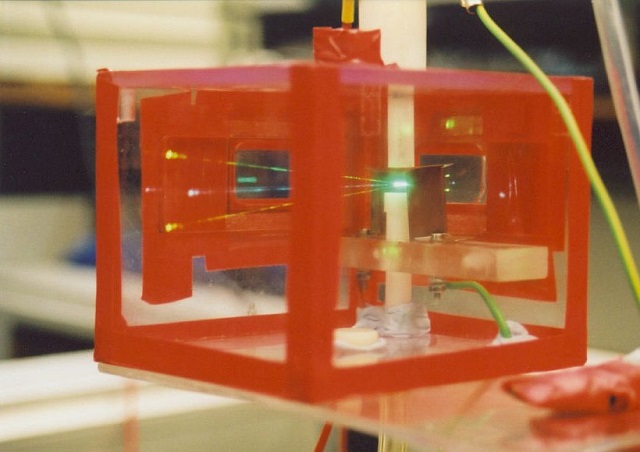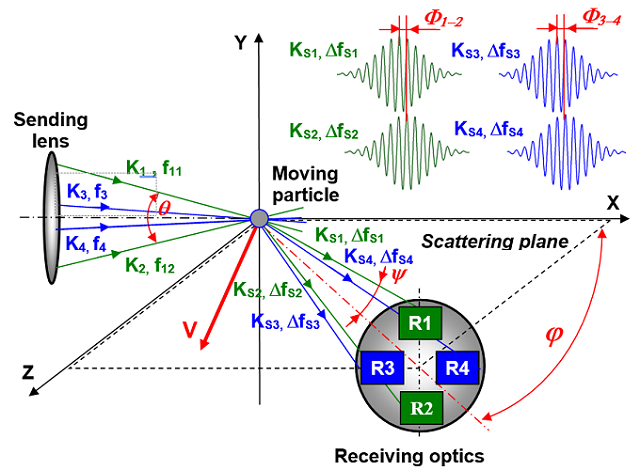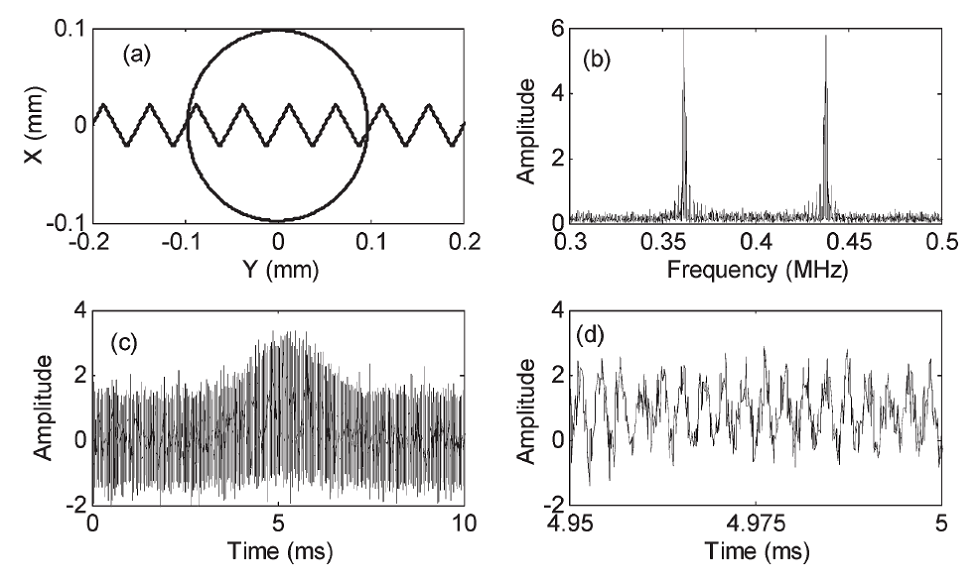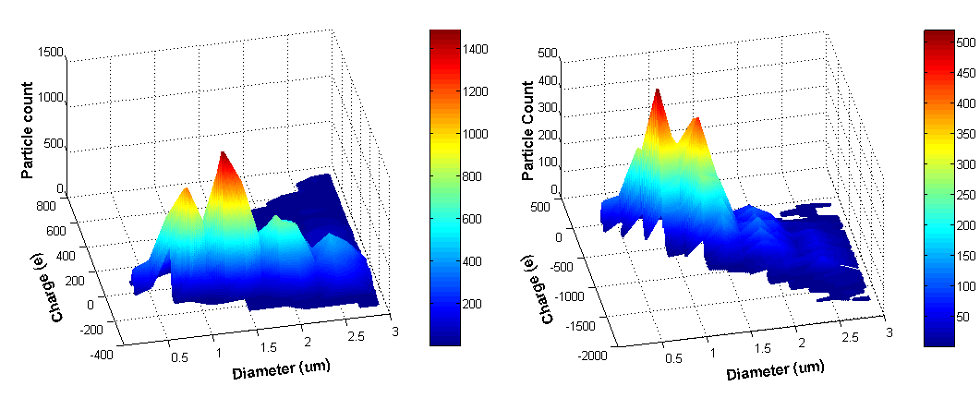Real-time Particle Size and Charge Analyser for Medical Inhalers
The knowledge of the electrostatic charge and size distribution of aerosol particles is very important in many industrial applications, such as gas cleaning, coating, printing, crop spraying and in many other fields. The specific charge on a particle or a droplet plays an important role in transporting and depositing sprays and aerosols. Many studies have demonstrated that the drug particles dispersion and deposition along the respiratory tract depends on several factors such as anatomy of the respiratory tract, breathing patterns, and characteristics of the inhaled particles including size and electrostatic charge. These studies provided compelling evidence that the electrical charge can affect the particles’ dispersion characteristic and significantly alter their respiratory deposition. Several mechanisms have been suggested in the literature to explain the charging process during droplet and particle formation. However, due to the complexity and the probabilistic nature of different charging mechanisms often acting simultaneously, it is very difficult to predict theoretically the charge distribution of aerosol particles or even estimate the relative effect of the different mechanisms. It has become apparent that it is essential to characterise aerosols not only in terms of their size distribution but also its bipolar electrical charge profile. Such measurements are often needed in real time especially if aerosol particles undergo rapid changes due to frequent collisions, evaporation, condensation, coagulation etc. Therefore, a non-invasive, fast and accurate experimental technique is vital to investigate the nature of aerosol electrostatics. Whereas, there are many well-established methods of particle size measurement the choice of methods for particle charge distribution measurement and especially simultaneous charge and size measurement is very limited.

Figure 1. Real-time Particle Size and Charge Analyser

Figure 2. Measurement volume
The main aim of this research project is to fill the existing gap on the market and design a novel fully functional measurement instrument capable of measuring in real time a bipolar charge and size distribution of aerosol particles. The proposed method of aerosol charge and size characterisation uses the Phase Doppler Anemometry (PDA) to track the motion of charged particles in the presence of an AC electric field. In the AC field the oscillating particle passing through the measurement volume generates frequency modulated Doppler Burst Signal (DBS), which contains the information about the amplitude of the particle velocity. By solving the equation of a particle motion in a viscous medium combined with the simultaneous measurement of its size and the velocity by the PDA system, the magnitude as well as the polarity of the particle charge is resolved. The present work concerns the development of the low cost integrated signal processing method based on Quadrature Demodulation and Correlation Techniques to obtain particle charge and size in real time.

Figure 3. Dual PDA arrangement
As shown in Figure 3 the Dual PDA combines four detectors in one single optical receiving probe. The basic principle of the Dual PDA is to perform two independent size measurements using two pairs of detectors perpendicular to each other one in X-Z plane and the other in Y-Z plane. Both measurements form the basis of a validation procedure eliminating the occurrence of misinterpreted size measurement.
Signal Processing
The simulation results of the DBS and the particle motion through the measurement volume at a drive frequency of 1 kHz are given in Fig. 3. Based on the spectral analyses of the DBS, it is shown that there are two dominant frequency components, which correspond to terminal particle velocities in both directions. Therefore, by searching these spectra for peak values, the constant particle velocity can be obtained. For example, two peak frequencies are shown in Fig. 4, fp1 = 362 kHz, and fp2 = 438 kHz, which correspond to the estimated particle velocities, Vxest1 = −87 mm/s, Vxest2 = 87 mm/s. The velocity estimation in the square-wave excitation field is implemented using the spectral analysis. In a search routine, the maximum spectral components are found. Then, the approximate frequency estimates are improved by an interpolation scheme. Interpolation is important, because the frequency resolution of the FFT is limited by the short duration of the bursts and the number of sampling points per burst. There are, however, two main additional challenges in the processing of DBS signals specific to the square-wave excitation. First, challenge is related to the presence of discontinuous signals when the oscillating particle moves in and out of the measurement volume even several times for one burst. Second, the challenge results from the fact that larger particles with relaxation time comparable with the excitation period will produce modulated DBS due to relatively long periods of acceleration and deceleration. In this case, the peak spectral lines that correspond to the terminal velocity are not easily identifiable, particularly if the particle trajectory via the measurement is off the center of the volume.

Figure 4. (a) Particle position in the measurement volume. (b) DBS spectrum. (c) DBS for q = 500e, d = 1 μm, Vx = 87.4 mm/s, f = 1 kHz, and SNR = 1.4 dB. (d) DBS detail.
Experimental results

Figure 5. Left: Particle charge and size distribution for naturally charged aerosol;
Right: Particle charge and size distribution from aerosol charged using negative corona source, corona voltage V= -4.5kV
The data were collected 20 measurement points with the total number of approximately 50 000 analyzed particles for each run. The three-dimensional graphs combining particle size and charge distribution are shown in Figures 5. Some broad trends may be noticed immediately. Particle charge as expected is seen to increase with increasing particle size. The aerosol is inherently bipolarly charged and contains similar amount of positively and negatively charged particles. The corona charging of droplets effectively eliminated one polarity of the charge and produced aerosol droplets that became predominantly unipolarly charged. The overall charge distribution for positive corona ranged from approximately 0 to about 1000, whereas for negative corona it ranged from 0 to –1200 elementary charges.
References:
- Zhang, L. Kulon J. and Yan Y., “Accuracy of the Frequency and Phase Measurement Concerning Different Noise Sources for Phase Doppler Anemometry”, IEEE International Conference on Smart Instrumentation, Measurement and Applications (ICSIMA 2015), 24-25 November 2015, Putrajaya, Malaysia.10.1109/ICSIMA.2015.7559037
- Zhang, L. Kulon J. and Yan Y., “Maximum likelihood estimator, FFT estimator and Cramér-Rao bounds of the laser Doppler frequency”. IEEE International Instrumentation and Measurement Technology Conference (I2MTC 2015), pp. 1198-1203 May 2015, Pisa, Italy. 10.1109/I2MTC.2015.7151443
- Kulon, J., Zhang, L., “The effect of a particle trajectory through the measurement volume on the accuracy of the laser Doppler frequency estimation,” IEEE Instrumentation and Measurement Technology Conference (I2MTC), pp.20-24, 12-15 May 2014. 10.1109/I2MTC.2014.6860515
- Kulon J., Roula M.A., AlDaher Z., Zhang L., An FFT based algorithm for particle charge measurement in the presence of a square‐wave excitation field using Phase Doppler Anemometry. IEEE International Conference on Industrial Technology (ICIT 2013), pp.1069-1074, Feb. 25-27, 2013, Cape Town, South Africa. 10.1109/ICIT.2013.6505820
- Rowland, M., Cavecchi, A., Thielmann, F., Kulon J., Shur, J., Price, R. ,The Bipolar Next Generation Impactor (bp-NGI) as a Tool for the Simultaneous Measurement of the Bipolar Charge Distribution and Mass Quantification of Aerosols for Inhalation. Drug Delivery to the Lungs 23 DDL23 Int. Conf. 5-7 Dec. 2012, Edinburgh, Scotland, UK, Pages 54-57. 10.1089/jamp.2013.ab01
- Kulon J., Roula M.A, Zhang L., Effects of System Parameters on Particle Statistics in Aerosol Charge and Size Measurement in Oscillatory Electric Fields, I2MTC Int. Instrument. Measurement Technology Conf., May 10-12, Hangzhou, China pp. 660-663, 2011. 10.1109/IMTC.2011.5944069
- Zhang L., Kulon J., Comparative Study of Square and Sine Wave Excitation Methods for the Measurement of Aerosol Particles Charge and Size Distribution using Phase Doppler Anamometry, IEEE Trans. Inst. Measurement, Vol. 60(4), pp. 1397-1407, April 2011. 10.1109/TIM.2010.2082498
- Zhang L., Kulon J., Cramer-Rao Bounds for a Laser Doppler Anemometer: The effect of the particle trajectory via the measurement volume, I2MTC Int. Instrument. Measurement Technology Conf., Austin, 3-6 May 2010, pp300-303. 10.1109/IMTC.2010.5488261
- Zhang L., Kulon J., Real-Time, Non-Invasive Measurement of Medical Aerosol Charge and Size Distribution Signal processing strategy, system modelling and optimization, I2MTC Int. Instrument. Measurement Technology Conf., Singapore, 5-7 May 2009, pp. 457-462. 10.1109/IMTC.2009.5168492
- Zhang L., Kulon J., Real-Time Particle Size and Charge Estimation from Laser Doppler Burst Signals using Quadrature Demodulation and Correlation Techniques. ICSP’08, Beijing, 26-29 October 2008, pp. 2677-2680. 10.1109/ICOSP.2008.4697700
- Zhang L., Kulon J., Real-Time Signal Processing Method for Obtaining Charge Distribution on Aerosols Produced by Medical Inhalers, 4th IEEE-EMBS International Summer School and Symposium on Medical Devices and Biosensors , Catharine’s College, Cambridge, UK, 19-22 August, 2007, pp. 90-93. 10.1109/ISSMDBS.2007.4338300
- Kulon J., Zhang L., PLL System Design for Simultaneous Analysis of Particle Charge and Size using Phase Doppler Anemometry, Applied Electronics 2007 International Conference, University of West Bohemia, Plzen, Czech Republic, 5 – 6 September 2007, pp. 117-120.
- Jaworek A., Balachandran W., Krupa A., Kulon J., Lackowski M., Wet Electrostatic Scrubbers For Exhaust Gas Cleaning- State of the art. Environ. Sci. Technol., 40 (20), pp. 6197 -6207, 2006.DOI: 10.1021/es0605927
- Jaworek A., Balachandran W., Lackowski M., Kulon J., Krupa A., Multinozzle electrospray system for gas cleaning processes, J.Electrostat. Vol. 64, pp. 194-202, 2006.DOI: 10.1016/j.elstat.2005.05.006
- Kulon J., Malyan B., Balachandran W., Simultaneous Measurement of Particle Size and Electrostatic Charge Distribution in DC Electric Field Using Phase Doppler Anemometry, IEEE Trans. Ind. Applicat., Vol. 39(5), pp. 1522-1528, 2003. 10.1109/TIA.2003.816460
- Balachandran W.,Jaworek A., Krupa A., Kulon J., M. Lackowski, Efficiency of Smoke Removal by Charged Water Droplets, J. Electrostat. Vol. 58, pp. 209-220, June 2003.
- Kulon J., Malyan B., Balachandran W., “Simultaneous Analysis of Particle Size and Electrostatic Charge Using Phase Doppler Anemometry System,” Proc. of the IEEE IAS 37th Annual Meeting, Pittsburgh, pp. 984-989, USA October 13-18, 2002. 10.1109/IAS.2002.1042677
